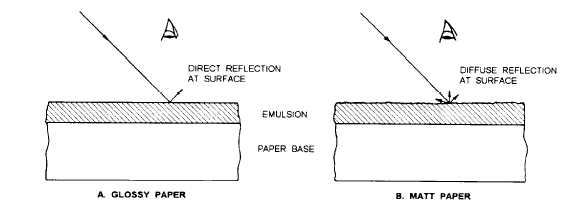RED SENSITIVE EMULSION LAYER - PRODUCES
CYAN DYES
GREEN SENSITIVE EMULSION LAYER -
PRODUCES MAGENTA DYES
BLUE SENSITIVE EMULSION LAYER - PRODUCES
YELLOW DYES
Figure 2-8.–Cross section of color printing paper.
When the same negative is exposed on another sheet of
paper with green light, a flat or not enough contrast print
is produced. When the normal-contrast negative is
printed with the proper combination of blue and green
light, a print with natural contrast is produced; therefore,
to control contrast when using variable contrast papers,
you can use a series of yellow and magenta filters to
control the amount of blue and green printing light
during exposure.
COLOR PRINTING PAPERS
Color printing papers are for printing color
negatives or color transparencies. Like color negative
films, color printing paper can be identified by the
suffixes “color” and “chrome.” These papers are
designed for printing color negatives and color
transparencies, respectively.
Like color films, color papers have three emulsion
layers. The order of the emulsions is reversed in
comparison to color films (fig. 2-8). The top emulsion
layer is sensitive to red light and produces cyan dyes,
the middle emulsion layer is sensitive to green light and
produces magenta dyes, and the bottom emulsion layer
is sensitive to blue light and produces yellow dyes.
PAPER SURFACES
Photographic papers are available in a variety of
paper surfaces, such as matt, semimatt, lustre, high
lustre, pearl, and glossy. The use of different paper
surfaces depends on the final application of the
photograph. There are two paper surfaces that arc used
frequently in Navy imaging facilities: glossy and matt.
Paper that has a smooth, glossy surface provides a print
with higher contrast and higher densities or color
saturations, resulting in an apparently sharper image.
This is due to the direct reflection quality of the paper
surface (fig. 2-9, view A). Glossy papers are always
used for photographic prints that are used to show fine
detail, such as equipment damage or intelligence
photographs.
Light reflected from MATT paper is diffused and
provides a softer, lower contrast image (fig. 2-9, view
B). Because of the lower contrast, subject detail does not
appear as sharp as an image on glossy paper. Matt papers
are used commonly for portraiture and scenic
photographs.
PROPER HANDLING AND STORAGE OF
FILMS AND PAPERS
Care in handling films and papers prevents
fingerprints, abrasions, and scratches on the surfaces of
these materials. You should particularly avoid
unnecessary contact between an emulsion surface and
any other object. Only handle light-sensitive materials
by the edges.
Light-sensitive materials should be removed from
their packages in a room that is clean, dust-free, and
lightproof. The workbench and your hands should be
clean and dry. Light-sensitive materials should be
Figure 2-9.–Reflection of light of different surface paper.
2-10



